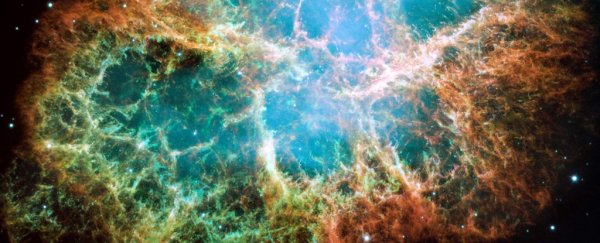It may have exploded nearly a thousand years ago, but the Crab Nebula is still spitting out radiation at incredibly high energies. In fact, astronomers have detected record-breakingly energetic photons coming from the object, clocking in at up to 450 trillion electron volts.
Previously, the highest energy photon ever detected was just 75 trillion electron volts, or teraelectronvolts (TeV). This marks the first time astronomers have detected such high energy photons - known as gamma rays - over 100 TeV.
The detection was made at ASgamma, a facility jointly run by China and Japan in Tibet. In 2014, it was upgraded to add underground water Cherenkov muon detectors; since then, they have made 24 gamma ray detections between 100 and 450 TeV.
For context, particles from the Sun are usually below 1 billion electronvolts, or GeV.
"This is the very first but a great step forward," said physicist Jing Huang of the Chinese Academy of Sciences. "It proves that our techniques worked well, and gamma rays with energies up to a few hundred TeV really exist."
When traced back to their source, these gamma rays seem to point directly to the Crab Nebula, a supernova remnant 6,500 light-years away, with the pulsing remains of a dead star in its centre - the Crab Pulsar.
This object is one of the most famous dead stars in the Milky Way, because it was the first in which a supernova remnant - the nebula itself - was traced to historical observations of a supernova. In 1054 CE the exploding star, which was bright enough to be seen during the day, was observed and recorded by Chinese astronomers.
Astronomers have also hypothesised that the object acts as a particle accelerator vastly more powerful than anything we can build on Earth. These newly discovered gamma ray photons could be proof of that.
Astronomers believe that, as the pulsar spins at its tremendous rate of once every 33 milliseconds, it emits a stellar wind of charged particles, including electrons accelerated up to the petaelectronvolt (PeV) range - that's one thousand trillion electron volts.
According to the new research, these electrons could be interacting with radiation from the cosmic microwave background (CMB), the radiation left over from the Big Bang that permeates the Universe. In turn, PeV electrons could accelerate CMB photons up to the TeV range, sending them careening out across the Universe.
The terrestrial particle accelerator called the Tevatron had a collision energy of up to 1 TeV (the LHC reaches 14 TeV). So the unofficial name for a PeV-range accelerator is "PeVatron".
When cosmic gamma rays get to Earth and collide with the atmosphere, they create a shower of harmless particles. It's these particles that the muon detector picks up; by analysing this particle shower, physicists can figure out what sort of photon caused it, and how much energy it carried.
The results of those 24 detections, the researchers said, indicate that the Crab Nebula could be the most powerful natural particle accelerator in the Milky Way.
And it could improve our understanding of high-energy cosmic particles and their sources, and how they are so powerful.
"Our goal," Huang said, "is to identify a lot of PeVatrons, which have not yet been discovered and are supposed to produce the highest-energy cosmic rays in our Galaxy."
The research has been accepted into the journal Physical Review Letters, and is available on arXiv.
